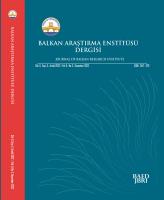MANASTIRLI KADINLARIN TAKI VE AKSESUAR KÜLTÜRÜ (1700-1730)
THE JEWELRY AND ACCESSORIES CULTURE OF THE WOMEN OF MANASTIR (1700-1730)
Author(s): Zülfiye KoçakSubject(s): Cultural history, 18th Century, The Ottoman Empire
Published by: Trakya Üniversitesi Balkan Araştırma Enstitüsü
Keywords: Manastır; Inheritance records; Woman; Jewelry; Accessory;
Summary/Abstract: Manastır, which is the second largest city of the current North Macedonia State, was taken under Ottoman rule after 1380 during the reign of Sultan Murad I. as it is located right in the middle of the east-west trade route called Via Egnatia between the Adriatic coasts and the Aegean Sea, it became one of the most important cities of Ottoman Rumelia within a short time. In the following decades, especially during the reigns of Murad II. and Mehmed II, Turkmen groups from the interior of Anatolia and the Taurus Mountains were settled in the region in a planned and organised manner. This led to an increase in the Turkish population in the region in a short time. As a result of this demographic movement, many mosques, inns, baths, bridges, imaret and madrasahs were built in the region, and the traditional Turkish-Islamic urban texture became dominant. The Ottoman Empire established its judicial organization in the city from the date it came under its rule and appointed a kadi here to solve the legal problems of the people. While solving all kinds of legal problems of the people, the kadi also served to transfer the cultural heritage to the present by keeping the court records. These records, known as the Şer‘iyye registers, contain a variety of subjects such as public life, central-provincial relations, regulations of local administrations, royal decrees, verdicts, deeds, berats, etc. Therefore, they have been one of the main reference sources of urban history and social history studies. In this study, inheritance records of ninety-eight women, which were scattered in the fourteen Şer‘iyye registers kept in the court of Manastır between 1700 and 1730, and in which the details of the inheritance from the deceased were recorded, were evaluated. Inheritance records contain information about deceased persons’ number of children, wealth, status, inheritance sharing, goods used, prices of goods and investment instruments. These sources, which can be evaluated in many ways in this sense, also give clues about what the jewelry and accessories used by the women of Manastır in the specified date range, what types of materials were made, and whether or not they changed according to the wealth of women, their level of welfare, and social status.
Journal: Balkan Araştırma Enstitüsü Dergisi -Trakya Üniversitesi
- Issue Year: 11/2022
- Issue No: 2
- Page Range: 453-490
- Page Count: 58
- Language: Turkish

